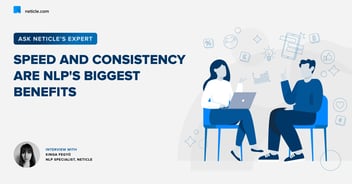Social listening is unaffected by who's asking the questions
When you begin working with Neticle, a team of experienced analysts will do their best to answer your research questions and aid you on your social listening or CX journey. This dedicated team is headed by Péter Zelenák, who, in this interview, told us about the changing role of text analytics in the lives of businesses, along with some of the benefits that often get overlooked.
-
You have been with Neticle for the past 8 years. How has the role and position of media analytics changed since you began?
One big difference is that collecting data used to be much easier. Platforms are now more cautious, but not without reason. Data breach scandals like the one involving Cambridge Analytica completely changed the landscape of social media analytics. For example, Facebook used to give us data from its public groups, but now this option is not available anymore, resulting in much less hits during any research, since relevant conversations are of course still happening in Facebook Groups. But we can’t analyze them, so clients need to be aware of this. On the other hand, users have also become a bit more cautious and conscious of what they’re posting online, also due to data security breaches.
Nevertheless, we still have a lot of data to analyze, and Facebook has become such a central hub that it adds a lot of value to our work. Comments on news portals are now disabled in most cases, conversations are instead happening under social media posts, and more intensely so than before. Overall, both the need and trust towards text and data analysis is increasing: companies do not only want social listening data, but they place an emphasis on collecting in-house and survey data as well, to collect and analyze as much feedback as possible. We call this a 360-degree view of a company’s reputation, which is very much possible these days.
-
What are the main benefits of market research with Neticle’s innovative tools, compared to more “traditional” market research?
Social listening is a very open form of feedback collection: the data that comes through isn’t influenced by the person asking questions, the structure and text of surveys or focus groups, or even client briefs. We can only analyze what we find online.
We usually have a ton of data, but we’ve had to learn that occasionally having zero hits is also a meaningful result. When a topic isn’t mentioned online, that’s also revealing: it might be a sensitive topic, or it might be irrelevant to users. That’s no fault of the research. Clients have increasing interest towards what we can offer, but their own topic can seem more important to them than what the online world reflects: it can be surprising that there are less hits, or opinions might be totally different than expected. But that’s the beauty of social listening.
Another great benefit is that we have a continuous stream of data, so we can check a topic historically any time. Data arrives in different formats from each platform, or even clients give data in different formats, but we can work with almost any, and we have a ton of metadata to work with too, which provides extra sources of insight. Speed is another advantage: we spare a lot of time to clients since no human effort is needed to read through responses. Analysis is therefore always consistent as well.
There are a few things to keep in mind, though. The environment we work in changes rapidly year to year, which is a special characteristic of media analytics compared to other fields of research, which is a challenge we sometimes must deal with.
When an analysis we did a few years ago needs to be repeated to see how things have evolved, results will not always be 100% comparable because the environment has changed so much. But we know how to handle these things. We must also be able to put results into perspective by benchmarks, to let the client know whether a certain engagement number, for example, is a great result or not.
-
Is there something that often surprises clients when conducting research with text analysis?
These are relatively new processes, which means that the outcomes are not standard at all. For example, when an analysis produces great insights, it’s often not obvious on the client’s side who the responsible person is to do something with that information. Who will take the next step? There are several departments in a company that might benefit, and it’s difficult to insert text analytics into their standard procedures, or there might be a lack of budget or time. The reason for this is that feedback collection via social listening, or via open questions in surveys includes all sorts of feedback, so they won’t only be getting it for one product or one aspect of their operation. This is of course an advantage, but it can be a challenge to use it wisely.
The methodology also surprises clients: they don’t always know it very well and so they aren’t aware of the many things it can do, especially complex custom label structures and the high level of customization are often a source of surprise and joy. With the help of these, we can cater to many different departments when companies don’t have insight managers.
Each country’s web has its own characteristics, too. A fun fact from Hungary is that online forums here are still extremely active hubs of conversation: people go into great depths there and clients often find this surprising. It’s such a great pool of insights!
-
How do you see the future of text analytics in CX and media analysis? Are there noticeable trends that clients are requesting more and more?
Yes, employer branding use cases are becoming more common – both in terms of outside image and among employees. Also, we see how automated text analysis is getting more emphasis within companies, as they’re becoming much more data-driven.
Text analytics are now often involved already from the beginning of a research project: we hold kickoffs and they want to know how we could best help them – they rely on us more and we work together to figure out details.
Thus, Neticle also serves an educational purpose. Occasionally, companies have or have collected a ton of data and they’re unsure what they could do with it, or what sorts of insights could be extracted. This is typical of industries on the rise, when processes are still undefined. We can always give good suggestions in such cases.
-
Is there a dream project that you know would be exciting and insightful to dig into with text- and media analytics?
Cross-country analyses are always exciting and provide extra insights to companies, so we would like to see more of them. For example, sports events or companies present in multiple countries are very good examples of where our capabilities come in handy. Our algorithm already speaks over 30 languages, so we’re very proud of the fact that we can provide insights in so many locations and across lots of industries.
Your own analysis is just a click away - let Neticle's experts guide you!
Share:


